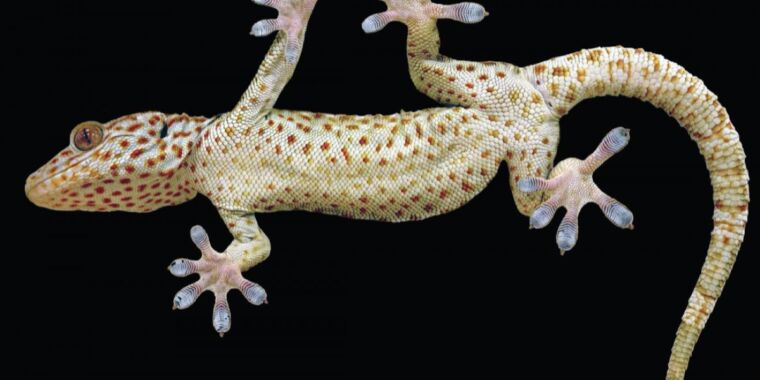
The diminutive gecko is capable of some extraordinary feats of locomotion, zipping along vertical walls with ease and even running short distances across water. Precisely how they accomplish these feats has long interested scientists. A new paper in Proceedings of the Royal Society B reports that geckos' ability to reorient their flexible toes is a major factor, enabling them to realign and adjust to shifts in gravity (load). The work may one day help to improve the design of bio-inspired robots.
This work builds on a 2018 study from the laboratory of University of California, Berkeley biophysicist Robert Full. Geckos are known for being expert climbers, able to stick to any surface thanks to the tiny hair-like structures on the bottoms of their feet. The little lizards can also zip along the surface of water at high speeds to elude predators. They can't do it for very long; the energy expenditure required is too great. But it's amazing that they can do it at all.
As we reported in 2018, those creatures in nature capable of walking on water employ different mechanisms depending on their size. Small, lightweight water striders, for instance, rely entirely on surface tension to stay afloat, while the larger, heavier basilisk lizards employ a slapping motion with their feet that creates pockets of air bubbles to keep from sinking. The standard theoretical calculations set very strict boundaries for how small an animal has to be to use surface tension and how large it needs to be before the surface slapping mechanism is viable.
Geckos fall somewhere in between. They are too large to rely solely on surface tension and too small to generate sufficient force to run along the surface of water without sinking. And yet they can still somehow accomplish the feat at lightning speed—almost one meter per second. When Full and his collaborators investigated, they found that the mouse-sized lizards use a combination of surface tension and a slapping motion to run across water.
Amazing gecko toes
-
The spotted belly of a Tokay gecko used by UC Berkeley biologists to understand how the animal's five sticky toes help it climb on many types of surface.Yi Song
-
Taking advantage of a phenomenon called frustrated total internal reflection, the researchers were able tell which parts of the toe pad (bright spots) were in contact with the surface and supporting the gecko’s weight.Yi Song
-
Close-up look at the toe pads of a Tokay gecko. They have many tiny hairs per foot, each of which has split ends that maximize contact with the surface and support the animal’s weight by interacting with surface molecules via van der Waals forces.Yi Song
-
A gecko in motion: sideways rotated upward climbing.YouTube/UC Berkeley
-
A gecko in motion: running over a slippery patch.YouTube/UC Berkeley
-
A gecko in motion: running across rods.YouTube/UC Berkeley
-
Hanging on: gecko grabs rod as its foot is pulled.YouTube/UC Berkeley
This time around, Full et al. have turned their attention to the question of why gecko toes only "stick" in one direction. Pull a foot in one direction and the gecko toes will grab onto a surface. Release the foot and the toes will "peel" in the opposite direction. That doesn't stop the agile gecko from moving any way it chooses. So Full gave Yi Song, a Berkeley student visiting from China, the task of figuring out what was going on. "A major challenge is the determination of how toe adhesive control rapidly modulates the foot forces that facilitate reliable attachment and fast locomotion, especially on natural substrates," the author wrote.
The team used 14 Tokay geckos in the experiments, which were conducted both at Berkeley and at Nanjing University of Aeronautics and Astronautics in China. They constructed a vertical track to study their toe orientation during motion. The animals ran in orthogonal directions along a wall and also ran sideways across slippery surfaces and vertically aligned acrylic rods. The toes would light up when they touched a given surface to highlight contact regions, thanks to a technique called frustrated total internal reflection. The team added slippery patches and rough irregular surfaces to study how the toes adjusted to changing terrain and also built an apparatus to measure just how tightly a gecko's toes gripped an acrylic rod as its foot was being pulled.
The team was surprised to find that the geckos could run sideways as quickly as they climbed upward, thanks to the ability to realign their toes. Having multiple toes proved useful when adjusting to slippery or irregular surfaces, for example. Those toes that maintained contact with the surface were able to shift orientation and better distribute the load. And because the toes are soft, the animals could more easily conform to rough surfaces.
"The research helped answer a fundamental question: Why have many toes?" said Full. “Toes allowed agile locomotion by distributing control among multiple compliant, redundant structures that mitigate the risks of moving on challenging terrain. Distributed control shows how biological adhesion can be deployed more effectively and offers design ideas for new robot feet, novel grippers, and unique manipulators.”
DOI: Proceedings of the Royal Society B, 2020. 10.1098/rspb.2020.0123 (About DOIs).
Listing image by Yi Song
"soft" - Google News
May 11, 2020 at 11:51PM
https://ift.tt/2WEDZtO
Gecko’s soft hairy toes reorient to help it stick to different types of surfaces - Ars Technica
"soft" - Google News
https://ift.tt/2QZtiPM
https://ift.tt/2KTtFc8
Bagikan Berita Ini















0 Response to "Gecko’s soft hairy toes reorient to help it stick to different types of surfaces - Ars Technica"
Post a Comment